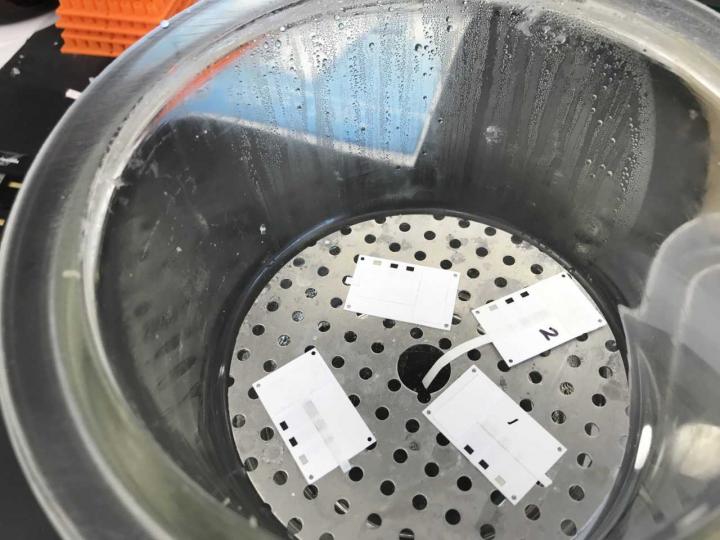UTSA researchers create method that can quickly and accurately detect infections

New electrochemical method developed at UTSA to test the presence of a bacterial infection is faster and more accurate than methods currently on the market. Photo courtesy of The University of Texas at San Antonio
A new study by Waldemar Gorski, professor and chair of the UTSA Department of Chemistry, and Stanton McHardy, associate professor of research in chemistry and director of the UTSA Center for Innovative Drug Discovery, describes a method that could show quickly and accurately whether a person has been infected with harmful bacteria or other pathogens. Additionally, this new method shows the exact severity of infection in a person.
The most common method of testing for infection in medical facilities is currently a strip that turns a certain color when infected fluids come into contact with it.
“The problem with this method is that it's imprecise,” Gorski said. “The human eye is forced to judge the level of infection based on the hue and deepness of a color. It's difficult to make an accurate call based on that.” Furthermore, roughly a third of samples cannot be tested because the fluids contain blood or are too opaque.
Other methods include microbiology or examining body fluid samples under a microscope and counting white blood cells, also known as leukocytes, which are an indicator of an infection. However, these can be slow processes and require more highly trained personnel.
Gorski, seeing a need for an easier and more rapid method of testing for infection, resolved to test an electrochemical approach, and sought out McHardy, a medicinal chemist. Together, they created molecules that bind to leukocyte enzymes and produce an electrical current to signal the presence of an infection.
Their new molecules are housed on a testing strip. After being contacted with infected bodily fluids, the strip is connected to a computer monitor that displays a clear range of electrochemical responses demonstrating the severity of an infection.
“The signs and symptoms people demonstrate aren't always reflective of the level of the infection they have,” McHardy said. “This device could very easily show just how serious an infection is and make diagnosis a much quicker process, possibly preventing a more serious illness.”
Gorski believes the method could be especially useful to people who have just undergone surgery, as it could determine definitively whether they have an infection from the procedure before it worsens.
To date, Gorski and McHardy have filed a patent for their invention, published two papers and plan to work with an engineer in the future to streamline its design.
###
Read Waldemar Gorski and Stanton McHardy's study, “Synthesis and Characterization of Pyridine Compounds for Amperometric Measurements of Leukocyte Esterase.”
Learn more about the UTSA Department of Chemistry.
Learn more about the UTSA Center for Innovative Drug Discovery.
Media Contact
All latest news from the category: Life Sciences and Chemistry
Articles and reports from the Life Sciences and chemistry area deal with applied and basic research into modern biology, chemistry and human medicine.
Valuable information can be found on a range of life sciences fields including bacteriology, biochemistry, bionics, bioinformatics, biophysics, biotechnology, genetics, geobotany, human biology, marine biology, microbiology, molecular biology, cellular biology, zoology, bioinorganic chemistry, microchemistry and environmental chemistry.
Newest articles

A ‘language’ for ML models to predict nanopore properties
A large number of 2D materials like graphene can have nanopores – small holes formed by missing atoms through which foreign substances can pass. The properties of these nanopores dictate many…

Clinically validated, wearable ultrasound patch
… for continuous blood pressure monitoring. A team of researchers at the University of California San Diego has developed a new and improved wearable ultrasound patch for continuous and noninvasive…

A new puzzle piece for string theory research
Dr. Ksenia Fedosova from the Cluster of Excellence Mathematics Münster, along with an international research team, has proven a conjecture in string theory that physicists had proposed regarding certain equations….



